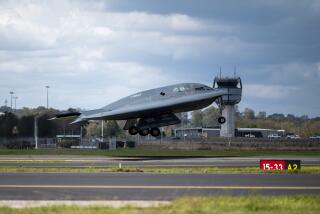U.S. flies bombers and fighter jets in a show of force against North Korea
- Share via
Reporting from SEOUL — The United States flew some of its most advanced warplanes in bombing drills with ally South Korea on Thursday, a clear warning after North Korea launched a midrange ballistic missile designed to carry nuclear bombs over Japan this week, South Korea’s military said. North Korea hates such displays of U.S. military might at close range and will likely respond with fury.
Two U.S. B-1B supersonic bombers and four F-35 stealth fighter jets joined four South Korean F-15 fighters in live-fire exercises at a military field in eastern South Korea that simulated precision strikes against the North’s “core facilities,” an official from Seoul’s Defense Ministry said. The B-1Bs were flown in from Andersen Air Force Base in Guam while the F-35s came from a U.S. base in Iwakuni, Japan, the official said. He didn’t want to be named, citing office rules.
The North, which claims Washington has long threatened Pyongyang by flaunting the powerful U.S. nuclear arsenal, describes the long-range B-1Bs as “nuclear strategic bombers” although the United States no longer arms them with nuclear weapons.
The dueling military displays open up the risk that things will get worse as each side seeks to show it won’t be intimidated.
North Korea has made it clear that it sees its weapons program, which demands regular testing to perfect, as the only way to contest decades of U.S. hostility, by which it means the huge U.S. military presence in South Korea, Japan and the Pacific. Washington, in turn, seeks with its joint drills with Seoul and bomber flights to show that it will not be pushed from its traditional role of supremacy in the region. More missile tests, more bomber flyovers and three angry armies at the world’s most heavily armed border raise the possibility that a miscalculation could lead to real fighting.
In Beijing, North Korea’s ally China warned that war is not an option in finding a solution to Pyongyang’s growing nuclear capabilities.
Defense Ministry spokesman Col. Ren Guoqiang told reporters that all parties should exercise restraint and avoid words and actions that escalate tension.
The bombing exercise came as the United States and South Korea wrapped up their annual Ulchi Freedom Guardian joint military drills that involved tens of thousands of soldiers. North Korea condemns the annual U.S.-South Korea war games as rehearsals for an invasion and described Tuesday’s launch over Japan as a countermeasure against the drills. Washington and Seoul faced calls to postpone or downsize this year’s drills.
The United States often sends its warplanes to South Korea, mostly for patrols, when animosity rises on the Korean Peninsula, which is technically in a state of war because the 1950-53 Korean War ended with an armistice, not a peace treaty.
North Korea on Tuesday flew a potentially nuclear-capable Hwasong-12 intermediate range missile over northern Japan and later called it a “meaningful prelude” to containing the U.S. territory of Guam. North Korean leader Kim Jong Un said the launch was a “curtain-raiser of its resolute countermeasures” against the U.S.-South Korea war games and called for his military to conduct more ballistic missile launches targeting the Pacific Ocean.
North Korea has been maintaining a torrid pace in weapons tests this year as it openly pursues an arsenal of nuclear-armed, intercontinental ballistic missiles capable of reaching deep into the U.S. mainland. Experts say Kim wants a real nuclear deterrent against the United States to ensure the survival of his government and likely believes that it will strengthen his negotiating position when North Korea returns to talks.
Pyongyang had earlier threatened to fire a salvo of Hwasong-12s toward Guam, which is home to key U.S. military bases and strategic long-range bombers the North finds threatening. It also flight tested a pair of developmental ICBMs in July.
South Korean analysts said the North’s threat against Guam and the launch over Japan on Tuesday are probably attempts to make launches over Japan an accepted norm and win itself greater military space in a region dominated by enemies.
The U.S. and South Korean militaries say the Hwasong-12 that the North fired over the northern Japanese island of Hokkaido flew about 1,677 miles. South Korea’s Vice Defense Minister Suh Choo-suk told lawmakers Thursday that the North might have fired the missile at about half its maximum range.
ALSO
U.S. officials condemn North Korea’s missile launch over Japan
In reversal of tradition, South Korean president unlikely to pardon Samsung scion
Singapore has an idea to transform city life — but there may be a privacy cost
More to Read
Sign up for Essential California
The most important California stories and recommendations in your inbox every morning.
You may occasionally receive promotional content from the Los Angeles Times.










